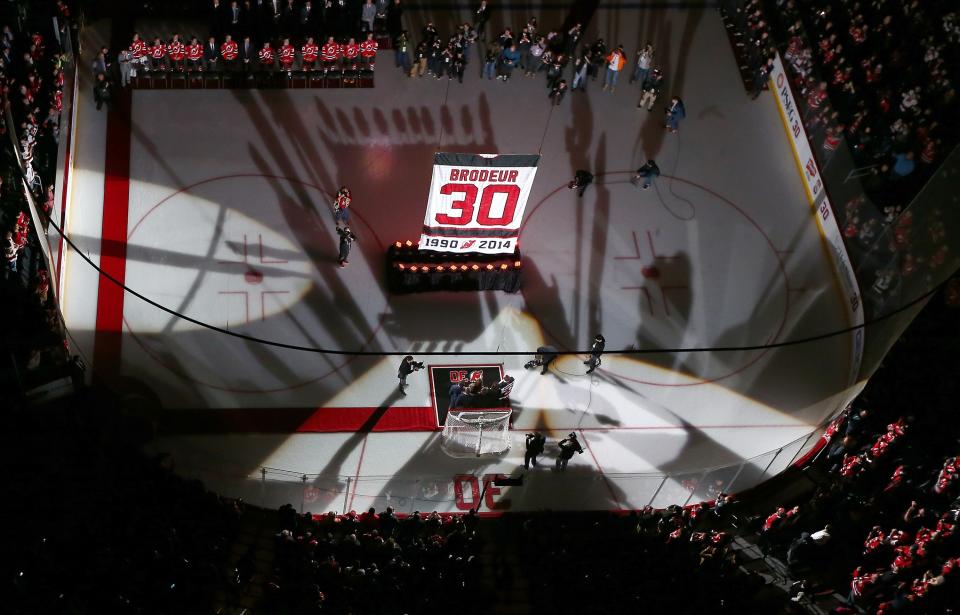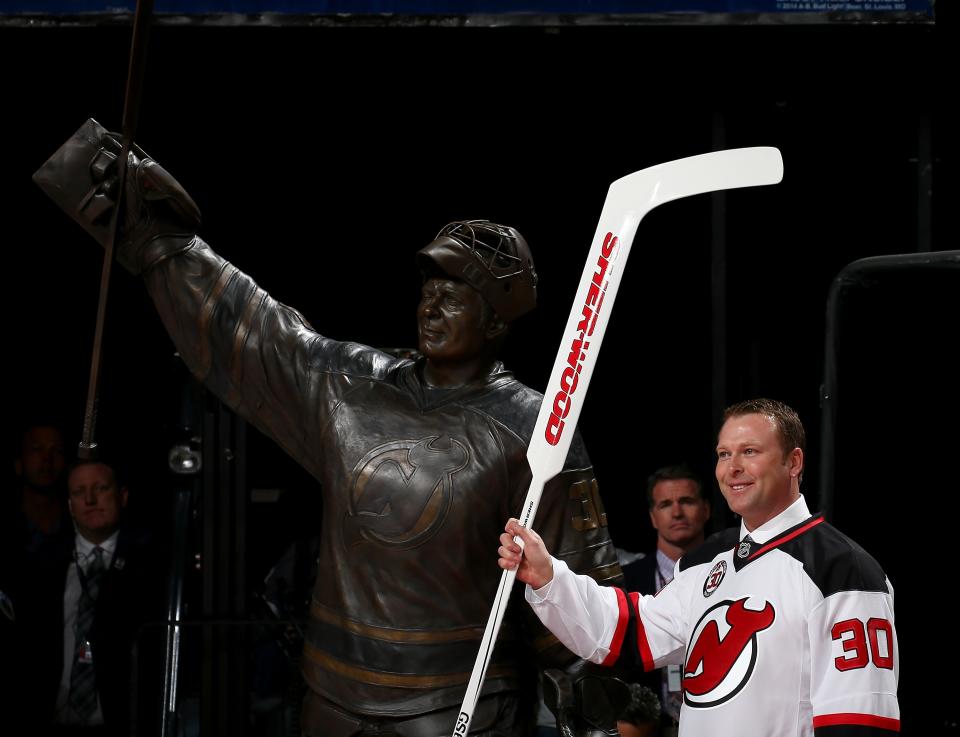Martin Brodeur, Devils fans finally have closure at number retirement

NEWARK, N.J. – New Jersey fans wear old jerseys.
It’s one of their most enduring qualities, along with sexually explicit chants about division rivals. Walk into any New Jersey Devils game at the Prudential Center, and you see menagerie of sweaters with names new, old, forgotten and comedic. (Yes, I’m talking to you, “No. 17 Ilya KovalSUCK” guy.)
On the night when Martin Brodeur’s jersey was retired, you could trace his career timeline through the fans’ fashion.
The hipsters in the No. 29 Christmas-colored jerseys, the first sweater Brodeur wore in the NHL, back when he was rocking a flat top and one of the worst peach-fuzz mustaches in the history of follicles.
The All-Star Game jerseys, from different eras and event formats. The Team Canada jerseys from his 2002 gold medal performance, which to this day Brodeur says is what elevated him to elite status. A few St. Louis Blues jerseys to remind us how it all ended. The jersey with “RANGERS SUCK” on the nameplate where “BRODEUR” should have been, because of course.
But mostly, the fans wore the two jerseys Brodeur himself wore for most of his 1,259 games with the Devils: Red, white and black, with the No. 30 on the back, matching the banner that now hangs above the rink.
Brodeur said he saw familiar faces wearing those jerseys on Tuesday night. They were the same faces he saw during three Stanley Cup championships and five conference titles. He used to be able to pick them out in the crowd at the Meadowlands, and then at the Rock. He would even notice when they’d switch seats.
“It’s not the biggest fan base, but it’s one of the best ones, because they’re so personable. They’re true fans,” said Brodeur. “If you play in Montreal, New York or Toronto, they’re so big that there’s zero personal touch with the fans.”
The fans felt out of touch when Brodeur retired as a St. Louis Blues goaltender – where he signed after a somewhat contentious departure from the Devils – and took a job in their front office. They didn’t have the catharsis of lauding him properly, celebrating his career.
Brodeur, in turn, didn’t have that closure with them, either.
So when Brodeur finally arrived at the podium – standing in front of a large goal net with his number inside of it, about 20 feet away from the Stanley Cup he hoisted three times – the fans sent a deafening “MARTY! MARTY!” chant echoing through the building.
He tried to speak. They didn’t let up. Mike “Doc” Emrick, the former Devils announcer who MC’d the event, walked over and told Brodeur to give it a moment, soak it in. So Brodeur turned to each section and raised a hand in appreciation.
“It was great. Something special for me,” he said.
“Because I knew it was going to be the last one.”
***
The number retirement was the finale of a multi-day celebration of Brodeur and his career by the Devils.
On Monday night, they unveiled a statue that Brodeur helped design, which captured a victorious stick salute from his playing days.

“I like it. I look fit,” said Brodeur. “When we picked the pose for the statue, we picked one that represented winning. Because when I lose, I don’t salute the crowd. I skate to the back and I feel shame.”
The rink had "No. 30" logos around the boards and, most hilariously, situated in the trapezoids behind each net -- a tribute to the rule the NHL had to create to keep Brodeur from acting like a third defenseman with his puck-handling prowess.
On Tuesday, the arena was filled with fans and chances for fans to honor Brodeur.
There were two different wall-sized signs thanking him that fans could write messages on:
There was a live painting being created by artist David Arrigo, best known for his work on NHL goalie masks:
There was a collection of Brodeur memorabilia on display from the Hockey Hall of Fame, including this hilarious sign from his appearance on “Live! With Regis And Kathy Lee.”
My favorite piece of Brodeur memorabilia at the Rock. #NJDevils #SaluteMB30 pic.twitter.com/djdCkZFVpb
— Greg Wyshynski (@wyshynski) February 9, 2016
Brodeur wasn’t exactly a regular on the talk show circuit, which is what happens when Lou Lamoriello is signing off on your media appearances. But that was Devils hockey. Brodeur’s star would only shine as bright as the shadow of the franchise would allow it.
“The name on the back of the shirt never got confused with the logo on the front,” said Lamoriello, speaking to the crowd before Brodeur’s number went to the rafters. “We won together. We lost together. We shared something very special.”
It’s a franchise standard that still made Brodeur feel a bit uncomfortable about the attention on Tuesday.
“It’s a little different. It’s the ‘I,’ instead of the ‘we.’ I had to switch it up [when talking],” he said.
Brodeur isn't the first number sent to the rafters in New Jersey, but it's a rarity.
"For over a decade of Brodeur’s career with the Devils, they didn’t have a number retired. Then we had Scott Stevens, Scott Niedermayer and Ken Daneyko, and now it’s me,” he said.
“Weird. It’s all defensive players.”
Such was Devils hockey.
***
Marty Brodeur was the Devils’ first franchise superstar. Scott Stevens came from the Blues and was a standout with the Capitals. Scott Niedermayer’s legendary status wasn’t cemented until he won a Cup outside of New Jersey, with the Anaheim Ducks. Brodeur was homegrown, from draft pick through three Cups and four Vezina trophies as the NHL’s top goaltender.
Yet he says it was the gold medal he won in 2002 as Team Canada’s goalie that really elevated his status in the NHL. Despite two Cup rings, there was a perception of him as a product of the Devils’ system, a cog in a machine. His performance in Salt Lake City was him serving notice, and the rest of the hockey world listened: All of his Vezinas arrived after that Olympic win.
Even with his success, his records and his accolades, it was hard for Brodeur to consider his own legend. Which is what happens when you’re a kid growing up in Montreal, looking up at those rafters, seeing those Hall of Fame names and knowing they belong there.
“There’s a reason why they’re so high. They’re almost unreachable,” said Brodeur.
“I grew up watching one of the best organizations in sports. My dad worked for them. And then we got Jacques Lemaire from them, and we became a good organization, too.”
Brodeur’s father, Denis, was a team photographer for the Montreal Canadiens before passing away in 2013. To say he taught Brodeur much about hockey and being a professional in the sport would be an understatement.
“You see your dad go in and out of the house because he has to work with athletes, you hear a lot of stories. You hear some good ones. You hear some bad ones. I see my dad come home late for dinner because of how an athlete was … that kind of stayed with me. That’s why I tried to be good. Sometimes I wasn’t,” said Brodeur.
In turn, Brodeur gave his father, and a goalie for the 1956 Canadian Olympic team, the opportunity to experience a pro career vicariously. “I gave him that opportunity to live it through me,” he said.
He delivered a message to his mother and siblings at the number retirement ceremony, choosing to do it in French to help him cope with the emotions. It was then he spoke about his father.
“He would have been so excited to be here,” said Brodeur. “We had a great relationship. I’m sad that he’s not here with us. But I’m sure he’s somewhere watching it.”
***
Brodeur heard a lot of chants on Tuesday, but one meant more to him than others.
In the afternoon before the ceremony, Brodeur entered a small room at Prudential Center. The Devils had amassed 200 or so team employees, who were there to greet him. He saw faces that helped put the game on each night. He saw faces that had helped him and his family for over 20 years while with the team.
And, in unison, he heard them chant his name: “MARTY! MARTY!”
Brodeur smiled thinking about it. “Wow, that was emotional. Because they were right in my face.”
He saw so many faces in Newark. Old friends. Old teammates. Old coaches. Old fans and fans that were in diapers when he started that are now season-ticket holders. They were an extended family, all part of the New Jersey Devils franchise that Brodeur and others helped build. “It’s in you. I don’t care if [Lou Lamoriello] is not there anymore, and I’m not part of the organization anymore. It’s in you.”
Moments before No. 30 was lifted to a place almost unreachable, Brodeur addressed the crowd. “Thank you for all the memories,” he said. “Thank you for all the ‘Marty’s Better’ chants.”
They chanted right back at him as he left the stage:
“THANK YOU, MARTY!”
--
Greg Wyshynski is a writer for Yahoo Sports. Contact him at puckdaddyblog@yahoo.com or find him on Twitter. His book, TAKE YOUR EYE OFF THE PUCK, is available on Amazon and wherever books are sold.

 Yahoo Sports
Yahoo Sports 

